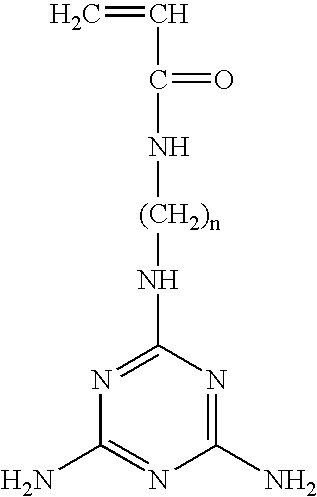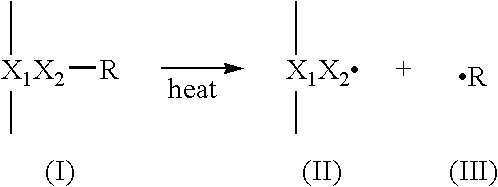Antimicrobial compositions and methods
- Summary
- Abstract
- Description
- Claims
- Application Information
AI Technical Summary
Benefits of technology
Problems solved by technology
Method used
Image
Examples
example 1
Preparation of Representative Polymeric Reagent including Photoreactive Groups and Melamine
[0141] A reagent was prepared that included aminopropyl methacrylamide (APMA) as a polymeric backbone and photoreactive groups attached to the polymeric backbone. A melamine group was then added to the reagent. Preparation of this reagent was as follows.
[0142] N—(3-Aminopropyl)methacrylamide hydrochloride (APMA) was prepared as described in Example 2 of U.S. Pat. No. 6,762,019. N[3-(4-benzoylbenzamido)propyl]methacrylamide (BBA-APMA) was prepared as described in Example 3 of U.S. Pat. No. 6,762,019. Copolymerization of APMA and BBA-APMA was performed as follows: a solution of BBA-APMA, AIBN, TEMED and DMSO was bubbled with argon. A solution of APMA / HCl in DI H2O, was bubbled with argon, and the two solutions were combined. The mixture was bubbled with argon for an additional period, then sealed and stirred in 55° C. overnight. The polymer solution was dialyzed against DI H2O and then lyophil...
example 2
Preparation of Representative Polymeric Reagent including Thermally-Reactive Groups and Melamine
[0145] Thermally-reactive melamine polymers were made in three steps—synthesis of the polymer backbone, then derivatization of the polymer backbone with melamine, followed by derivatization with thermally reactive perester moieties.
Synthesis of Polymer Backbone, Poly(DMA:APMA) (50:50):
[0146] 3 g (16.8 mmol) of Aminopropylmethacrylamide-hydrochloride (APMA-HCl) (Aldrich Chemicals, Milwaukee, Wis.), 0.039 g (0.24 mmol) of 2,2′-azo-bis-isobutyrylnitrile (AIBN) (Aldrich Chemicals, Milwaukee, Wis.) and 1.73 ml (16.8 mmol) of N,N-dimethylacrylamide (DMA) (Aldrich Chemicals, Milwaukee, Wis.) were dissolved in 34 ml dimethylsulfoxide (DMSO). Nitrogen gas was bubbled through the reaction solution for at least 5 minutes. Next, 0.052 ml (0.7 mmol) of β-mercaptoethanol (Aldrich Chemicals, Milwaukee, Wis.) and 0.025 ml (0.17 mmol) of N,N,N′,N′-tetramethylethylenediamine (TEMED) (Aldrich Chemicals,...
example 3
Preparation of Representative Monomer including Melamine (Compound C)
[0153] This synthesis of a melamine monomer is accomplished in two steps—addition of ethylenediamine to a melamine derivative, and then conjugation of the remaining amino group on ethylenediamine to acryloyl chloride.
Synthesis of Ethylenediamine-Melamine:
[0154] 2.9 g of 2-chloro-4,6-diamino-1,3,5-triazine was suspended in 30 ml DI water. To this suspension, 5 ml ethylenediamine was added and the mixture was heated to reflux under stirring. 10 ml 10% NaOH solution was added dropwise until the solution became clear. The reaction mixture was cooled to room temperature and filtered. The filtrate was concentrated to 20 ml and placed in the refrigerator overnight. The crystallized product was collected and dried under vacuum.
Synthesis of Melamine-Aminoethyl Acrylamide:
[0155] 1.53 g (10 mmol) ethylenediamine-melamine was dissolved in 30 ml pyridine. 1.0 g (11 mmol) of acryolyl chloride was added dropwise over 30 mi...
PUM
| Property | Measurement | Unit |
|---|---|---|
| Temperature | aaaaa | aaaaa |
| Composition | aaaaa | aaaaa |
| Energy | aaaaa | aaaaa |
Abstract
Description
Claims
Application Information
 Login to View More
Login to View More - R&D
- Intellectual Property
- Life Sciences
- Materials
- Tech Scout
- Unparalleled Data Quality
- Higher Quality Content
- 60% Fewer Hallucinations
Browse by: Latest US Patents, China's latest patents, Technical Efficacy Thesaurus, Application Domain, Technology Topic, Popular Technical Reports.
© 2025 PatSnap. All rights reserved.Legal|Privacy policy|Modern Slavery Act Transparency Statement|Sitemap|About US| Contact US: help@patsnap.com



